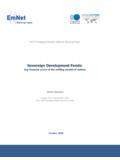Transcription of Study of Hong Kong’s Industry Level …
1 Strategic Access Limited, Room 1004, F/10 Wilson House, 19 Wyndham Street, Central, hong kong Tel.: (852)2866-9579 Fax: (852)2866-9895 Study of hong kong s Industry Level Competitiveness The Garments Sector 2 Introduction For the greater part of the past half century, the textiles and garment industries have provided the engine room of the hong kong economy . At their peak, they accounted for almost 450,000 jobs, spread across approximately 16,500 factories. But the past two decades have literally decimated these industries, if basic data are to be accepted at face value.
2 In 2005, hong kong s Census and Statistics Department reported fewer than 3,000 establishments involved in the textile and garment industries, employing fewer than 46,000 people (see Chart 1, Chart 2). 3 Chart 1 Garment Sector Textiles Sector Garment & Textile Year Establishments Workers Establishments Workers Establishments Workers 1980 10,474 306,785 5,966 136,900 16,470 443,685 1985 9,704 276,342 4,799 113,930 14,503 390,272 1990 8,938 220,901 5,556 112,598 14,494 333,499 1995 3,117 80,545 2,925 51,747 6,042 132,292 2000 1,620 27,658 1,784 29,272 3,404 56,930 2004 1,330 24,143 1,580 22,440 2,910 46,580 Chart 2 Source: Census & Statistics Department, HKSAR hong kong Garment & Textile.
3 JobsGarment SectorTextiles Sector050,000100,000150,000200,000250,00 0300,000350,000400,000450,000500,0001980 19851990199520002004 YearJobsGarment SectorTextiles SectorHong kong Garment & Textile : EstablishmentsGarment SectorTextiles Sector02,0004,0006,0008,00010,00012,0001 4,00016,00018,00019801985199019952000200 4 YearEstablishmentsGarment SectorTextiles Sector 4 The improbable rise of these industries in a compact city location like hong kong , and the subsequent decline, provide a fascinating insight into the emergence over the past five decades of globally-organised business.
4 They also tell clearly the story of China s disengagement, and subsequent re-engagement with the global economy , and of hong kong s indispensable role in facilitating this re-engagement. Perhaps most important of all, they provide insights into the remarkable flexibility and versatility of the hong kong economy and hong kong -based businesses over the past half century, which leaves hong kong s garment manufacturers still today a leading global force in the sector, in spite of the dramatic shrinkage in their hong kong -based workforces.
5 Strikingly, those 46,000 workers today accounted in 2004 for sales valued at HK$50 billion more than 10% higher than the HK$45 billion in sales generated by more than 440,000 workers in 1980. From Rags to riches in half a century: a brief history of hong kong s garment Industry hong kong s emergence as a global force in the textile and garment sectors is both accidental and extraordinary, from its earliest days determined by events on the Chinese Mainland. The victory of Mao Zedong and the Communist Party in 1949 after decades of civil war resulted in the hermetic closure of China from almost all outside contact, and in particular economic contact.
6 As Chinese industrialists sought safe haven, many flooded into hong kong and found themselves staying in spite of any particular expectation at the time. Shanghai s textile and garment barons arrived in large numbers with hastily dismantled industrial equipment, and they lost no time in putting their manufacturing roots down in tiny hong kong . Almost overnight, hong kong inherited a textile and garment Industry which within a few years grew to become a global force in the export of textiles and apparel of all kinds.
7 5 As world textile exports tripled between the late 1970s and the late 1990s, with garment exports almost quadrupling 1, hong kong emerged as the world s third most important exporter in the sector, behind only the European Union and China (much of whose exports were also attributable to hong kong companies). This growth was in spite of and perhaps even because of unstinting efforts on the part of European and garment manufacturers to slow the penetration of hong kong exporters into their domestic markets.
8 As these protectionist interests lobbied the Governments of Europe and the US to keep hong kong exporters at bay, so their efforts played a vital role both in consolidating, and then in accelerating the global dispersal of garment manufacturing under hong kong ownership. How so? First, the establishment of the Multi Fibre Arrangement in 1974, and the global quota system for garment trade created by it, had the effect of cementing hong kong s leadership. The process of assigning quota based on global trade as it existed at the time enabled established exporters like hong kong to capture and retain a dominant position in global trade that may not have been so easily defended in free market circumstances.
9 With such a large part of the garment trade subject to severely limiting quotas, manufacturers were also persuaded to compete by seeking higher value-added in each garment, and to innovate with materials like ramie and silk, and novel mixtures of them, that fell outside the remit of the quota system. Second, successive efforts to block imports by changing the industrial processes that determined the country of origin of particular garments forced on the Industry a flexibility and versatility that might otherwise never have emerged.
10 The highlighting of particular stages of the manufacturing process to confer country of origin prompted garment manufacturers to disaggregate 1 * Textile Restrictions and hong kong s Textiles and Clothing Industry , Richard Wong, Ka Fu Wong, Asia Case Research Centre, The University of hong kong , 2004 6 these stages, and in due course to separate them geographically to meet the ever-shifting country of origin requirements. It is arguable that this pressure, which over three decades has led garment manufacturers to disperse their manufacturing operations cross dozens of different countries, provided the original template upon which was based the practice of dispersed manufacturing in many industrial other industrial sectors.






